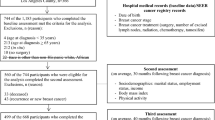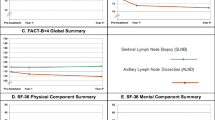Abstract
Purpose
The aim of this study was to evaluate the ratio of significant weakness in the affected arm of breast cancer-related lymphedema patients to their unaffected side. Another purpose was to identify factors related to arm weakness and physical function in patients with breast cancer-related lymphedema.
Methods
Consecutive patients (n = 80) attended a single evaluation session following their outpatient lymphedema clinic visit. Possible independent factors (i.e., lymphedema, pain, psychological, educational, and behavioral) were evaluated. Handgrip strength was used to assess upper extremity muscle strength and the disabilities of arm, shoulder, and hand (DASH) questionnaire was used to assess upper extremity physical function. Multivariate logistic regression was performed using factors that had significant differences between the handgrip weakness and non-weakness groups.
Results
Out of the 80 patients with breast cancer-related lymphedema, 29 patients (36.3 %) had significant weakness in the affected arm. Weakness of the arm with lymphedema was not related to lymphedema itself, but was related to the fear of using the affected limb (odds ratio = 1.76, 95 % confidence interval = 1.30–2.37). Fears of using the affected limb and depression significantly contributed to the variance in DASH scores.
Conclusions
Appropriate physical and psychological interventions, including providing accurate information and reassurance of physical activity safety, are necessary to prevent arm weakness and physical dysfunction in patients with breast cancer-related lymphedema.
Similar content being viewed by others
References
(2012) Annual report of cancer statistics in Korea in 2010
(2013) Statistics of mortality cause. Korean statistical information service
Bosompra K, Ashikaga T, O'Brien PJ, Nelson L, Skelly J (2002) Swelling, numbness, pain, and their relationship to arm function among breast cancer survivors: a disablement process model perspective. Breast J 8:338–348
Rockson SG (1998) Precipitating factors in lymphedema: myths and realities. Cancer 83:2814–2816
Kilbreath SL, Refshauge KM, Beith JM, Ward LC, Lee M, Simpson JM, Hansen R (2012) Upper limb progressive resistance training and stretching exercises following surgery for early breast cancer: a randomized controlled trial. Breast Cancer Res Treat 133:667–676
Schmitz KH, Ahmed RL, Troxel AB, Cheville A, Lewis-Grant L, Smith R, Bryan CJ, Williams-Smith CT, Chittams J (2010) Weight lifting for women at risk for breast cancer-related lymphedema: a randomized trial. JAMA 304:2699–2705
Schmitz KH, Ahmed RL, Troxel A, Cheville A, Smith R, Lewis-Grant L, Bryan CJ, Williams-Smith CT, Greene QP (2009) Weight lifting in women with breast-cancer-related lymphedema. N Engl J Med 361:664–673
Kim do S, Sim YJ, Jeong HJ, Kim GC (2010) Effect of active resistive exercise on breast cancer-related lymphedema: a randomized controlled trial. Arch Phys Med Rehabil 91:1844–1848
Smoot B, Wong J, Cooper B, Wanek L, Topp K, Byl N, Dodd M (2010) Upper extremity impairments in women with or without lymphedema following breast cancer treatment. J Cancer Surviv 4:167–178
Dawes DJ, Meterissian S, Goldberg M, Mayo NE (2008) Impact of lymphoedema on arm function and health-related quality of life in women following breast cancer surgery. J Rehabil Med 40:651–658
Sander AP, Wilson J, Izzo N, Mountford SA, Hayes KW (2012) Factors that affect decisions about physical activity and exercise in survivors of breast cancer: a qualitative study. Phys Ther 92:525–536
Teresa S, Lee P, Kilbreath SL, Sullivan G, Refshauge KM, Beith JM, Harris LM (2009) Factors That affect intention to avoid strenuous arm activity after breast cancer surgery. Oncology Nursing Forum 36:454–462
Dominick SA, Natarajan L, Pierce JP, Madanat H, Madlensky L (2014) The psychosocial impact of lymphedema-related distress among breast cancer survivors in the WHEL Study. Psychooncology 23:1049–1056
Bijur PE, Silver W, Gallagher EJ (2001) Reliability of the visual analog scale for measurement of acute pain. Acad Emerg Med 8:1153–1157
Kindler CH, Harms C, Amsler F, Ihde-Scholl T, Scheidegger D (2000) The visual analog scale allows effective measurement of preoperative anxiety and detection of patients' anesthetic concerns. Anesth Analg 90:706–712
Beck AT, Ward CH, Mendelson M, Mock J, Erbaugh J (1961) An inventory for measuring depression. Arch Gen Psychiatry 4:561–571
Ambrosini PJ, Metz C, Bianchi MD, Rabinovich H, Undie A (1991) Concurrent Validity and psychometric properties of the beck depression inventory in outpatient adolescents. J Am Acad Child Adolesc Psychiatry 30:51–57
Sagen A, Karesen R, Risberg MA (2009) Physical activity for the affected limb and arm lymphedema after breast cancer surgery. A prospective, randomized controlled trial with two years follow-up. Acta Oncol 48:1102–1110
van Sloten TT, Savelberg HH, Duimel-Peeters IG, Meijer K, Henry RM, Stehouwer CD, Schaper NC (2011) Peripheral neuropathy, decreased muscle strength and obesity are strongly associated with walking in persons with type 2 diabetes without manifest mobility limitations. Diabetes Res Clin Pract 91:32–39
Mathiowetz V, Weber K, Volland G, Kashman N (1984) Reliability and validity of grip and pinch strength evaluations. J Hand Surg [Am] 9:222–226
Hladiuk M, Huchcroft S, Temple W, Schnurr BE (1992) Arm function after axillary dissection for breast cancer: a pilot study to provide parameter estimates. J Surg Oncol 50:47–52
Rietman JS, Dijkstra PU, Debreczeni R, Geertzen JH, Robinson DP, De Vries J (2004) Impairments, disabilities and health related quality of life after treatment for breast cancer: a follow-up study 2.7 years after surgery. Disabil Rehabil 26:78–84
Petersen P, Petrick M, Connor H, Conklin D (1989) Grip strength and hand dominance: challenging the 10 % rule. Am J Occup Ther 43:444–447
Finch E BD, Stratford PW, Mayo NE (2002) Physical rehabilitation outcome measures. BC Decker Inc. 2nd edition
Sagen A, Kaaresen R, Sandvik L, Thune I, Risberg MA (2014) Upper limb physical function and adverse effects after breast cancer surgery: a prospective 2.5-year follow-up study and preoperative measures. Arch Phys Med Rehabil 95:875–881
Lebel S, Rosberger Z, Edgar L, Devins GM (2007) Comparison of four common stressors across the breast cancer trajectory. J Psychosom Res 63:225–232
Baker F, Denniston M, Smith T, West MM (2005) Adult cancer survivors: how are they faring? Cancer 104:2565–2576
Lebel S, Tomei C, Feldstain A, Beattie S, McCallum M (2013) Does fear of cancer recurrence predict cancer survivors' health care use? Support Care Cancer 21:901–906
Thewes B, Butow P, Bell ML, Beith J, Stuart-Harris R, Grossi M, Capp A, Dalley D, Committee FCRSA (2012) Fear of cancer recurrence in young women with a history of early-stage breast cancer: a cross-sectional study of prevalence and association with health behaviours. Support Care Cancer 20:2651–2659
Chmielewski TL, Jones D, Day T, Tillman SM, Lentz TA, George SZ (2008) The association of pain and fear of movement/reinjury with function during anterior cruciate ligament reconstruction rehabilitation. J Orthop Sports Phys Ther 38:746–753
de Jong JR, Vlaeyen JW, Onghena P, Cuypers C, den Hollander M, Ruijgrok J (2005) Reduction of pain-related fear in complex regional pain syndrome type I: the application of graded exposure in vivo. Pain 116:264–275
Fritz JM, George SZ (2002) Identifying psychosocial variables in patients with acute work-related low back pain: the importance of fear-avoidance beliefs. Phys Ther 82:973–983
Leeuw M, Goossens ME, Linton SJ, Crombez G, Boersma K, Vlaeyen JW (2007) The fear-avoidance model of musculoskeletal pain: current state of scientific evidence. J Behav Med 30:77–94
Heuts PH, Vlaeyen JW, Roelofs J, de Bie RA, Aretz K, van Weel C, van Schayck OC (2004) Pain-related fear and daily functioning in patients with osteoarthritis. Pain 110:228–235
George SZ, Fritz JM, Childs JD (2008) Investigation of elevated fear-avoidance beliefs for patients with low back pain: a secondary analysis involving patients enrolled in physical therapy clinical trials. J Orthop Sports Phys Ther 38:50–58
Linton SJ, Boersma K, Jansson M, Svard L, Botvalde M (2005) The effects of cognitive-behavioral and physical therapy preventive interventions on pain-related sick leave: a randomized controlled trial. Clin J Pain 21:109–119
Herrero F, San Juan AF, Fleck SJ, Balmer J, Perez M, Canete S, Earnest CP, Foster C, Lucia A (2006) Combined aerobic and resistance training in breast cancer survivors: A randomized, controlled pilot trial. Int J Sports Med 27:573–580
Hayes SC, Rye S, Disipio T, Yates P, Bashford J, Pyke C, Saunders C, Battistutta D, Eakin E (2013) Exercise for health: a randomized, controlled trial evaluating the impact of a pragmatic, translational exercise intervention on the quality of life, function and treatment-related side effects following breast cancer. Breast Cancer Res Treat 137:175–186
Jeffs E, Wiseman T (2013) Randomised controlled trial to determine the benefit of daily home-based exercise in addition to self-care in the management of breast cancer-related lymphoedema: a feasibility study. Support Care Cancer 21:1013–1023
Acknowledgments
This work was supported by the National Research Foundation of Korea (NRF) grant funded by the Korean government by the Ministry of Science, ICT and Future Planning (No. 2012R1A1A3010877).
Conflict of interest
No potential conflict of interest relevant to this article was reported.
Author information
Authors and Affiliations
Corresponding author
Rights and permissions
About this article
Cite this article
Lee, D., Hwang, J.H., Chu, I. et al. Analysis of factors related to arm weakness in patients with breast cancer-related lymphedema. Support Care Cancer 23, 2297–2304 (2015). https://doi.org/10.1007/s00520-014-2584-6
Received:
Accepted:
Published:
Issue Date:
DOI: https://doi.org/10.1007/s00520-014-2584-6




